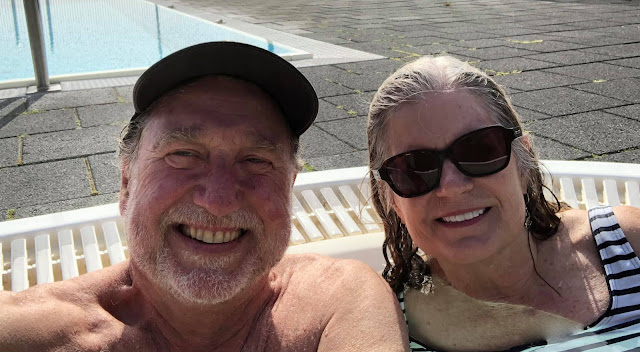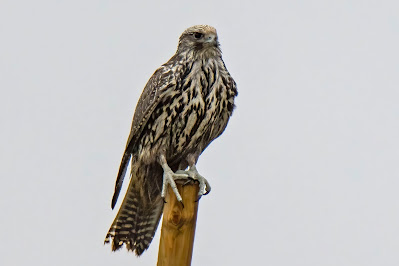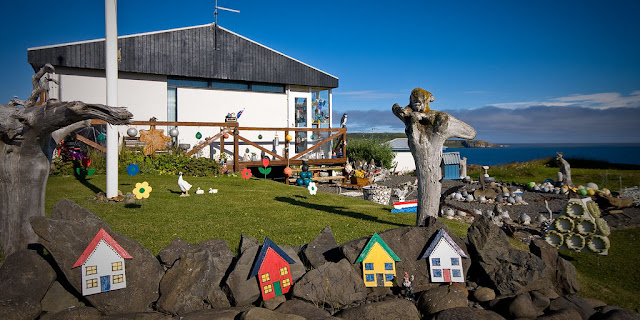 |
| A wild landscape |
 |
| Photo: Booking.com |
There were signs, but all we could find was a hotel and conference center, that looked decidedly unfinished, although it wasn't.
Once again, Iceland is confusing. Because here was a town named Reykjanes, very far from the Reykjanes Peninsula south of Reykjavik. The name means “smoking peninsula.” I guess Iceland has a lot of smoking peninsulas.
After Reykjanes, we skirted the end of Ísafjarðardjúp, which is called Ísafjörður (not to be confused with the nearby town of Ísafjörður).
A bridge spans the marshy terminus of the fjord and then follows the opposite side of Ísafjörður. It then turns abruptly and heads away from the water and up into the mountains.
This was the first place where sport fishing seemed to be a major pastime. We saw lots of fishermen and a cool fish ladder.
The high plain is green and rugged. We saw a cute little building that we stopped to photograph.
 |
| This was an unexpected treat! |
It had a note on the door that said it was a private hot spring that was open for anyone to use if the door was unlocked.
All they asked was that guests be neat and clean up after themselves. The door was unlocked, so I went in.
 |
| Photo: Scott Stevens |
It was a lovely tub flanked by changing benches. Such a cute little place. We didn’t get in the water – but we could have! And, that is pretty cool. Plus, it was very clean and neat.
 |
| Left, the indoor pool; Right, the original spring |
Hólmavík
Our next stop was a Hólmavík, a fishing village with 375 inhabitants.
Hólmavík is the home of the famous Strandagaldur Museum of Sorcery and Witchcraft. Dedicated to the folklore and history of sorcery and witchcraft in Iceland (which was a big deal), the Museum opened in 2000.
 |
| The museum looks very homegrown |
It contains permanent and special exhibitions on some very grisly topics, including spells and counterspells that often involved human mutilation.
 |
| Yuck! |
I mean, there is a display on necropants, which is literally pants made from a dead person’s leg skin, that allegedly resulted in a cash windfall for the wearer. More likely, wearing necropants resulted in execution.
Accordingly, the Museum also covers the history of witch hunts in Iceland, and the genealogy of witches and their accusers.
While witches are traditionally thought of as female, those accused of witchcraft in Iceland were traditionally male. Many were prosecuted and executed. Some were just executed. Villagers with torches and all …
 |
| I certainly wouldn't plan a trip around a visit to this museum |
It was definitely a small homegrown museum, but it had lots of artifacts, some real and some replicas. It just was not my cup of tea … or goblet of brew ...
 |
| The town sign looks homegrown, too, but in a delightful way |
But, it was on the way. Hólmavík is also where Láki Tours does its Vestfirðir whale watches. It was such a pretty day, I kind of wish we had planned one.
But, we continued on to Drangsnes.
 |
| Hólmavík's docks |
Drangsnes
The tiny town with 67 inhabitants has an idyllic setting on a thumb of land where Steingrímsfjörður empties into Húnaflói Bay. It faces Grímsey Island, but not the Grímsey Island known for being the most northerly part of Iceland (the only part above the Arctic Circle). This is a different one (Iceland!).
 |
| A lighthouse on Grímsey Island, which is across from Drangsnes |
Drangsnes is famous for its free hot tubs that sit right by the road overlooking the bay. The three baths are all fed by the naturally heated spring beneath them. One is cool, one is allegedly quite hot (it didn’t feel that hot) and one is warm. There is a public changing room across the street. The Drangsnes pools are a popular spot to watch the Northern Lights during the freezing winter.
Drangsnes is named for a tall rock that is said to be one of three troll women who tried to separate Vestfirðir from the rest of Iceland.
 |
| More great food |
We arrived and ate lunch (delicious fish soup, mushroom soup and a tuna sandwich to split) on the deck of the hotel before exploring the Hot Tubs (it was too early to check in to our hotel, so we would have to use the public dressing rooms).
We did not find the Tubs very appealing – small, not too hot and one was a bit green. Plus, there were quite a few people (with beers) getting into them.
We opted instead to visit the community swimming pool and hot tub. It cost only $8.00 to get in. It had a nice dressing room and showers. It provided towels and we were the only ones there.
 |
| The Drangnes community pool; Photo: Scott Stevens |
It was very nice. Very nice to soak in warm waters under the Icelandic sunshine. Very nice to have a clean dressing room. And very nice to not have to cuddle up with strangers.
 |
| Another trip selfie – in the hot tub |
Hot pools – natural, constructed and combinations – have been part of the Icelandic culture since at least the 9th century. Now, community pools are common, even in communities so small you cannot believe that a pool is financially possible. In fact, there are more than 160 community pools in Iceland. And, Iceland has only 63 communities that qualify as towns.
Of course, heating the pools is no problem because of Iceland’s geothermal energy. In most communities, the pools are a year-round site for socializing.
When we checked in to the Malarhorn Guesthouse ...
 |
| The guesthouse had a variety of rooms and a great restaurant; our room is on the left |
... where we had a huge, nicely appointed room ...
 |
| The room was ginormous |
Another nice accommodation!
Exploring
We spent the afternoon exploring a partially paved loop road (road 645) north of town.
 |
| Much of the road was unpaved |
The area we enjoyed most had steep cliffs above inlets and bays.
 |
| The area has steep cliffs |
The shore was littered with more driftwood than I have ever seen anywhere else.
 |
| What is happening here? |
 |
| This is a large tree in Iceland |
Now, a reforestation program is underway to help bring the forests back. But, most of those trees are small.
A popular Icelandic joke goes:
"What should you do if you're lost in an Icelandic forest?”
"Stand up."
Driftwood fills the gap for building and firewood. So, where does it come from? Primarily Siberia.
Most of the driftwood is spruce, pine and larch that grew beside rivers.
 |
| The rugged coast is a landing spot for escaped Siberian timber |
The trees fell or, more often, escaped from logging operations and were washed to sea, where they floated with Arctic Ocean currents for about five years before washing up in Iceland.
But, that’s not the whole story. Driftwood can only stay afloat for about ten months before it gets waterlogged and sinks. How does it make it five years?
 |
| The saturated wood is sturdy |
Sea ice. When the ocean freezes, the wood can't sink, extending the time it can stay on its journey.
During this time, this particular wood gets saturated with sea salt, making it super hard and super durable (pretty much the same way petrified wood is created, but faster).
Since the wood belongs to whoever owns the land it washes up on, it is a cost-effective building material and sometimes a cash crop.
Much of it is used for fenceposts, an important item in a rural area with more sheep than people.
 |
| Icelanders decorate with driftwood that looks like giant birds or dinosaurs; Photo: Scott Stevens |
The area we liked best along 645 had a sea stack. We stopped several times over two days, so we saw it in high and low tide.
 |
| The beautiful sea stacks |
Scott droned and I photographed the Common Eiders ...
 |
| A common Eider stretching its wings |
This is one of the few places we saw adults and ducklings ...
 |
| The group was mainly adults, but there were some ducklings |
We also saw Mallard ducklings ...
 |
| Swimming in a row to meet up with Mom in the weeds |
There were lots of Northern Fulmars and Black-legged Kittiwakes that I never bothered to photograph and a very wary Badger-faced Sheep ...
 |
| This is one of the many morphs of Icelandic Sheep |
The first evening, we had a great encounter – a gray morph Gyrfalcon. I had seen a Gyrfalcon years and years ago in Alaska, but never photographed one. When we first saw it, it was close to the road, but on the opposite side of the car from me and I missed the shot before it flew away.
Gyrfalcons
So, I searched and searched and searched and finally spotted it on a rock further away than I would like (in rapidly approaching twilight). But I got passable photos. If only I had gotten it at the first opportunity!
 |
| A great sighting! |
The largest member of the falcon family, the Gyrfalcon stands 19 to 25½ inches tall and has a wingspan from 43 to 63 inches. Like most raptors, females are much bulkier and larger than males.
 |
| A brown morph juvenile; you'll see it again later |
Some disperse more widely after the breeding season or in winter. Gyrfalcons tend to be solitary and can travel long distances.
Plumage varies with location, with birds being colored from all-white to dark brown. Greenland Gyrfalcons are lightest, with white plumage flecked with grey on the back and wings.
 |
| A large, powerful bird; Photo: NatureGreenland |
Icelandic birds tend towards pale, whereas the Eurasian populations are considerably darker and typically incorporate no white birds.
Although Gyrfalcons have no formal subspecies, the Icelandic population is thought to be the most genetically distinct.
The Gyrfalcon was originally thought to be a bird of only tundra and mountains; however, in 2011, researchers found they spend considerable periods during the winter on sea ice far from land.
 |
| Photo: eBird |
Their diet is to some extent opportunistic, but a majority breed and hunt coinciding with Ptarmigan and seabird colonies. Avian prey ranges in size from songbirds to geese and mammals from shrews to marmots. Gyrfalcons rarely eat carrion.
 |
| Peregrines I have photographed elsewhere |
Like Peregrines, Gyrfalcons nest on cliff faces, often on bare ledges or abandoned Golden Eagle or Common Raven nests.
Their only natural predators are Golden Eagles, which seldom bother them.
 |
| My Gyrfalcon! |
Gyrfalcons have been recorded as aggressively harassing animals (including Brown Bears) that come near their nests, although Common Ravens are the only predators known to successfully pick off Gyrfalcon eggs and hatchlings.
Humans, of course, are the biggest threat through hunting, automobile collisions and poisoning animals that Gyrfalcons eat. Gyrfalcons that survive into adulthood can live up to 20 years.
I had hoped I would see a Gyrfalcon, but doubted I would.
So far, Vestfirðir had delivered both Arctic Foxes and a Gyrfalcon! And, when I got home, I learned that the Gyrfalcon is the "National Animal of Iceland."
 |
| The National bird; Photo: Einfon |
Fairy Town
While in Drangsnes, we noticed many homes had fairy or troll houses – some quite elaborate – in the yard. I meant to photograph some, but didn’t. Many also had fake Owls, perhaps warding off Ravens or seabirds?
 |
| I meant to take a photo; Photo: Joe Griffith on FLICKR |
 |
| You see a lot of these in northern Iceland; Photo: Scott Stevens |
 |
| Photo: Scott Stevens |
I mentioned that we had eaten lunch at Malarhorn. We also had dinner there (not many other choices in town – perhaps not any other choices). It was wonderful. Scott had halibut and I had sand dab. We noticed that the fish in Iceland is much softer than how we serve it in the U.S. We aren’t sure if it is a characteristic of the fish or of the cooking style. While I prefer a slightly firmer, dryer fish, you certainly couldn’t match the flavor.
It was our last night in Vestfirðir. The next day, we would be heading to Norðurlands and rejoining (for a while) the Hringvegur.
Trip date: August 13-September 1, 2021





No comments:
Post a Comment